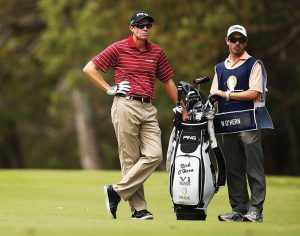The media nicknamed me ‘Mr Consistency’ throughout my playing days because I had a lot of top-10 finishes and always seemed to be there or thereabouts at the end of tournaments. Now, I was never a player that overpowered golf courses by smashing the ball 300-plus yards and hitting high, towering long irons. Instead, I thought my way around, managing what I had by playing to my strengths and avoiding my weaknesses. I tried to avoid result-oriented thoughts on the golf course, instead focusing on the processes required to achieve the results. For me it started with the most important process of all, the Pre-Shot Routine (PSR).

Most golfers have heard of a PSR but what exactly is it? Simply put, a PSR is the process before hitting a shot that puts you in the best possible state mentally and physically to execute a quality golf shot. Having a reliable and repetitive PSR is essential. There’s no one PSR that’s ideal; it’s like the golf swing. There’s no one particular way to swing a golf club because we’re all unique individuals with our own tendencies and traits.
I loved the PSR of the late, great Severiano Ballesteros, and was fortunate enough to play with him a couple of times during the latter stages of his career. By that point he was struggling with his full swing, hitting the ball all over the course, but get him within 100 yards of the green and he was a magician. Seve would have these animated discussions with his caddie about the shot at hand, then walk into the ball like a predator stalking his prey. It was almost like a theatrical performance.
I have two phases to my PSR: decide and execute. The decide phase is the thinking part where I’m gathering all the relevant information before pulling the club out of the bag. For instance, how far have I got, where’s the wind coming from, is it uphill/downhill, and so on. Once I take in all this information, I decide on what shot I want to hit, such as a high fade or a low draw. For most golfers something reasonably straight is usually sufficient enough. The key here is to take in all the information, and make a committed decision on the shot you want to hit.
Moving into the execute phase, I pull the club from my bag, stand behind the ball and, as Jack Nicklaus used to say, ‘go to the movies’, visualising the flight of the ball, where it lands and rolls to. Then, I take a practice swing feeling the motion to replicate that shot. I always have a swing thought, which typically revolves around rhythm and tempo – nothing too technical. That’s for the practice area. It’s always only one thought because through vast experience, I’ve realised I can only ever think of one thing at a time – unlike my wife! After my practice swing, I walk into the ball fully committed to the shot at hand, take a couple of looks at the target followed by a long waggle and let it go. What you do over the ball is up to you, but keeping it simple is the best option, so no outside thoughts have a chance to come in to your mind.
In summary, the decide phase is the thinking or logical part of the PSR; the execute phase is the reacting part. That’s why I like to break up my PSR into two phases. I think about the shot at hand (decide), and then react (execute). If I do this every time I walk up to my ball on the golf course, then I’m OK with whatever result occurs because I gave it everything I had, and that’s all I can do.
When you have a process in place to focus on, you won’t think about the result, because you only focus on what you have to do in that exact moment. Which is: trust your process.



